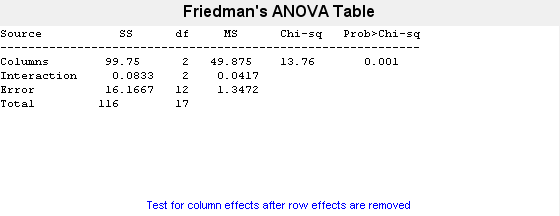Friedman's test is similar to classical balanced two-way ANOVA, but it tests
only for column effects after adjusting for possible row effects. It does not test
for row effects or interaction effects. Friedman's test is appropriate when columns
represent treatments that are under study, and rows represent nuisance effects
(blocks) that need to be taken into account but are not of any interest.
The different columns of X represent changes
in a factor A. The different rows represent changes
in a blocking factor B. If there is more than one
observation for each combination of factors, input reps indicates
the number of replicates in each “cell,” which must
be constant.
The matrix below illustrates the format for a set-up where column
factor A has three levels, row factor B has two levels, and there
are two replicates (reps=2). The subscripts indicate
row, column, and replicate, respectively.
Friedman's test assumes a model of the form
where μ is an overall location parameter, represents the column effect, represents the row effect, and represents the error. This test
ranks the data within each level of B, and tests for a difference
across levels of A. The p that friedman returns
is the p value for the null hypothesis that . If the p value
is near zero, this casts doubt on the null hypothesis. A sufficiently
small p value suggests that at least one column-sample
median is significantly different than the others; i.e., there is
a main effect due to factor A. The choice of a critical p value
to determine whether a result is “statistically significant”
is left to the researcher. It is common to declare a result significant
if the p value is less than 0.05 or 0.01.
Friedman's test makes the following assumptions about the data
in X:
All data come from populations having the same continuous
distribution, apart from possibly different locations due to column
and row effects.
All observations are mutually independent.
The classical two-way ANOVA replaces the first assumption with
the stronger assumption that data come from normal distributions.
